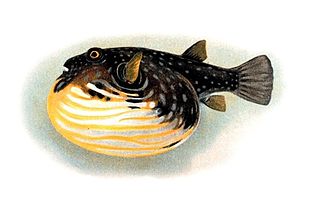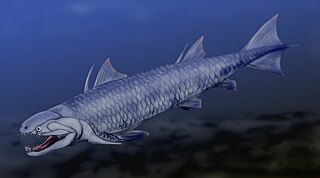
Tetraodontidae is a family of primarily marine and estuarine fish of the order Tetraodontiformes. The family includes many familiar species variously called pufferfish, puffers, balloonfish, blowfish, blowers, blowies, bubblefish, globefish, swellfish, toadfish, toadies, toadle, honey toads, sugar toads, and sea squab. They are morphologically similar to the closely related porcupinefish, which have large external spines.

Tetraodontiformes, also known as the Plectognathi, is an order of ray-finned fishes which includes the pufferfishes and related taxa. This order has been classified as a suborder of the order Perciformes, although recent studies have found that it, as the Tetraodontoidei, is a sister taxon to the anglerfish order Lophiiformes, called Lophiodei, and have placed both taxa within the Acanthuriformes. The Tetraodontiformes are represented by 10 extant families and at around 430 species overall. The majority of the species within this order are marine but a few may be found in freshwater. They are found throughout the world.

In zoology, a scale is a small rigid plate that grows out of an animal's skin to provide protection. In lepidopterans, scales are plates on the surface of the insect wing, and provide coloration. Scales are quite common and have evolved multiple times through convergent evolution, with varying structure and function.

The snailfishes or sea snails, are a family of marine ray-finned fishes. These fishes make up the Liparidae, a family classified within the order Scorpaeniformes.

Stethacanthus is an extinct genus of shark-like cartilaginous fish which lived from the Late Devonian to Late Carboniferous epoch, dying out around 298.9 million years ago. Fossils have been found in Australia, Asia, Europe and North America.
This glossary of ichthyology is a list of definitions of terms and concepts used in ichthyology, the study of fishes.

Edaphodon was a fish genus of the family Callorhinchidae. As a member of the Chimaeriformes, Edaphodon was a type of rabbitfish, a cartilaginous fish related to sharks and rays. The genus appeared in the Aptian age of the Lower Cretaceous and vanished in the Pliocene. It was most prominent during the Late Cretaceous. Many Edaphodon species were found in the Northern Hemisphere, but species from the Southern Hemisphere are also known.

Psarolepis is a genus of extinct bony fish which lived around 397 to 418 million years ago. Fossils of Psarolepis have been found mainly in South China and described by paleontologist Xiaobo Yu in 1998. It is not known certainly in which group Psarolepis belongs, but paleontologists agree that it probably is a basal genus and seems to be close to the common ancestor of lobe-finned and ray-finned fishes. In 2001, paleontologist John A. Long compared Psarolepis with onychodontiform fishes and refer to their relationships.

Liparis, commonly known as widelip orchids, sphinx orchids or 羊耳蒜属 is a cosmopolitan genus of more than 350 species of orchids in the family Orchidaceae. Plants in this genus are terrestrial, lithophytic or epiphytic herbs with a wide range of forms. The flowers are usually resupinate and small to medium sized, yellow, yellow-green or purplish with spreading sepals and petals. The labellum is usually larger than the sepals and petals and is lobed, sometimes with a toothed or wavy margin and one or two calli at its base.

Campbellodus decipiens is an extinct ptyctodontid placoderm fish that lived around 380 million years ago. Its fossil remains have been found preserved in perfect three-dimensional form from the Gogo Formation of Western Australia. Originally it was described from large tooth plates and isolated skull roof bones by Miles & Young (1977). Long (1995) restored the complete fish based on new material found at Gogo in the mid 1980s, and described by Long (1997).

Cylindracanthus is an extinct, enigmatic genus of marine ray-finned fish with fossils known throughout North America, Europe, Asia and Africa from the Late Cretaceous to the late Eocene, with potential Oligocene records and a possible Miocene record also known. It is exclusively known from its distinctive partial remains, which are long cylindrical bony spines that are usually considered rostrum fragments, as well as some associated teeth. These spines are abundant & widespread throughout this timespan, and are useful indicators of a nearshore marine environment, but the taxonomic identity of the fish is still highly uncertain and debated.

Liparis montagui, or Montagu's seasnail, is a marine fish of the seasnail family (Liparidae). It inhabits the northeastern Atlantic, mainly around the British Isles, the North Sea, the Norwegian Sea, southern Iceland and as far north as the Barents Sea. It is a small, demersal fish, usually living between from the intertidal zone to 30 metres deep, where it hides under stones or algae. It mainly feeds on small invertebrates, such as small crabs, shrimp and amphipods. This species was described in 1804 by the Anglo-Irish writer, natural history illustrator, and amateur zoologist Edward Donovan with England given as the type locality. The specific name honours the English naturalist George Montagu who provided Donovan with an illustration and a description of this "beautiful little fish".

Liparis is a large genus of snailfish from the northern hemisphere. They are very common in temperate and cold waters. Chernova (2008) has proposed that the genus should be subdivided into five subgenera: Liparis, Neoliparis, Lycocara, Careliparis, and Lyoliparis.

Liparis atlanticus, the Atlantic snailfish or Atlantic seasnail, is a species of marine ray-finned fish belonging to the family Liparidae, the snailfishes. This species is found in the western Atlantic Ocean off the eastern coast of North America.

Girella nigricans, commonly known as the opaleye or rudderfish, is a species of sea chub found in the Eastern Pacific, from California to southern Baja California. A rarely documented isolated population also exists in the Gulf of California, which might be genetically different from the rest of the species. They are commonly found in shallow waters and intertidal zones, usually over rocks and kelp beds, at depths of 1 to 32 m. They feed primarily on algae, but will occasionally consume sessile invertebrates. They are considered commercially important game fish.

Sebastes diploproa, the splitnose rockfish, is a species of marine ray-finned fish belonging to the subfamily Sebastinae, the rockfishes, part of the family Scorpaenidae. It is found in the northeastern Pacific Ocean.

Dracopristis is an extinct genus of ctenacanth that lived during the Carboniferous period in North America, around 307 million years ago. The species was discovered in the Kinney Brick Quarry in New Mexico, US. Like many fossils from the site, the fossils of Dracopristis are very well-preserved. A single species is known, Dracopristis hoffmanorum, which is named in honor of Ralph and Jeanette Hoffman, the owners of the quarry. Prior to being scientific named, D. hoffmanorum was informally referred to as the "Godzilla shark".

Liparis gibbus, the polka-dot snailfish, variegated snailfish or dusky snailfish, is a species of marine ray-finned fish belonging to the family Liparidae, the snailfishes. This fish is found in Arctic waters. Juveniles of the species have been found to be biofluorescent.

















